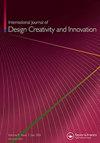Design creativity research: recent developments and future challenges
IF 2.5
Q4 ENGINEERING, MANUFACTURING
International Journal of Design Creativity and Innovation
Pub Date : 2019-08-19
DOI:10.1080/21650349.2019.1646387
引用次数: 4
Abstract
In 1983 Howard Gardner (1983/2011) first published ‘Frames of mind: The theory of multiple intelligences’. His view that intelligence can take many forms and is contingent on particular disciplines and on socio-cultural circumstances was revolutionary and had a lasting influence on the study of intelligence. This theory shuttered the former belief that intelligence is innate, and that it can be universally measured in the form of a standard IQ score. Gardner listed seven (later the list was extended to nine) basic types of intelligence, which translate into learning styles: visual-spatial, bodily-kinesthetic, musical, interpersonal (later dubbed emotional or social intelligence), intrapersonal, linguistic and logical-mathematical. Gardner, who is a prominent creativity researcher as well, did not come up with a similarly innovative theory of creativity; instead, he demonstrated extraordinary creativity in a range of different disciplines. A generation ago the study of creativity was largely descriptive and included much anecdotal material. In parallel, assessments of creativity continued to emphasize divergent thinking, as proposed by Guilford (1950) and evident in fluency, flexibility and originality (later elaboration was added), for which Torrance (1974) developed the most prevalent creativity tests. There are many offshoots of the original 1970s’ tests, but they continue to rest on the same principles. Two main factors have changed creativity theories in more recent times. First, artificial intelligence (AI), which has become a strong simulation and development tool in studies of intelligence, has been instrumental also in creativity research. One of the first scholars to illuminate the role of AI in analyzing as well as generating creative ideas is Margaret Boden, who distinguishes between two levels of creativity. The first is connectionist, whereby familiar ideas are combined in novel ways. A higher level of creativity is achieved by “mapping, exploration and transformation of conceptual spaces” (Boden, 1991/2004). AI models can “help define a space”, and show how it is navigated when acts of mapping, exploration and transformation are performed. When this theory was first presented, AI tools could only explore spaces. Today we have tools that can also transform them, thus assisting in the production of creative ideas. The second factor that has a profound impact on creativity research is neurological and neurocognitive sciences, which have, in recent years, been able to expand creativity research from the realm of cognition and the mind into the realm of the brain. In particular, the combinatorial theories of creativity which talk about associations of ideas can now be demonstrated in terms of patterns of neural connections in the brain, with the help of contemporary imaging technologies such as fMRI (e.g., Ellamil, Dobson, Beeman, & Christoff, 2012; Gabora, 2010; Goel, 2014; Lazar, 2018). This line of research has helped weaken the hitherto dominating view of the ‘exclusivity’ of divergent thinking in creativity. Even with simpler tools than imaging, it is now possible to show that convergent thinking is equally important in creative thinking, including in design. Furthermore, since we can now work with finer resolutions in research, we can also defy the paradigm that creative design consists of prolonged divergent phases followed by convergent ones. Goldschmidt (2016) has demonstrated that shifts between divergent and convergent segments of thought are very frequent and occur throughout the idea generation phase of creative design. In conclusion, the important developments of the last decade or two resemble the progress that had transpired earlier in the study of intelligence. On the one hand, we realize that our research must be conducted at a much finer grain than had been done before, and we now have the tools to do so, in collaboration with other relevant scientific disciplines such as neuroscience. Anecdotal INTERNATIONAL JOURNAL OF DESIGN CREATIVITY AND INNOVATION 2019, VOL. 7, NO. 4, 194–195 https://doi.org/10.1080/21650349.2019.1646387设计创意研究:近期发展和未来挑战
1983年,霍华德·加德纳(1983/2011)首次发表了《心智框架:多元智能理论》。他认为智力可以有多种形式,取决于特定的学科和社会文化环境,这是革命性的,对智力研究产生了持久的影响。这一理论推翻了以前的观点,即智力是天生的,可以用标准智商分数的形式来普遍衡量。加德纳列出了七种(后来扩展到九种)基本类型的智力,这些智力转化为学习风格:视觉空间、身体动觉、音乐、人际(后来被称为情感或社会智力)、人际、语言和逻辑数学。加德纳也是一位杰出的创造力研究者,他没有提出类似的创新创造力理论;相反,他在一系列不同的学科中展现了非凡的创造力。上一代人以前,对创造力的研究主要是描述性的,包括许多轶事材料。与此同时,正如Guilford(1950)所提出的,对创造力的评估继续强调发散思维,并在流畅性、灵活性和独创性方面表现得很明显(后来增加了详细阐述),托伦斯(1974)为此开发了最普遍的创造力测试。20世纪70年代最初的测试有很多分支,但它们仍然基于相同的原则。两个主要因素在最近的时代改变了创造力理论。首先,人工智能(AI)已经成为智能研究中强大的模拟和开发工具,在创造力研究中也发挥了重要作用。Margaret Boden是最早阐明人工智能在分析和产生创造性想法中的作用的学者之一,她区分了创造力的两个层次。第一种是联结主义,将熟悉的想法以新颖的方式结合在一起。通过“概念空间的映射、探索和转换”实现了更高水平的创造力(博登,1991/2004)。人工智能模型可以“帮助定义一个空间”,并显示在进行映射、探索和转换时如何导航。当这一理论首次提出时,人工智能工具只能探索空间。今天,我们拥有的工具也可以改变它们,从而帮助产生创造性的想法。对创造力研究产生深远影响的第二个因素是神经和神经认知科学,近年来,这些科学能够将创造力研究从认知和思维领域扩展到大脑领域。特别是,在现代成像技术(如fMRI)的帮助下,现在可以从大脑中神经连接的模式来证明谈论想法关联的创造力组合理论(例如,Ellamil、Dobson、Beeman和Christoff,2012;Gabora,2010;Goel,2014;Lazar,2018)。这一研究路线有助于削弱迄今为止关于创造力中发散思维的“排他性”的主流观点。即使使用比成像更简单的工具,现在也有可能表明,趋同思维在创造性思维中同样重要,包括在设计中。此外,由于我们现在可以在研究中以更高的分辨率进行工作,我们也可以挑战创造性设计由长期的发散阶段和随后的收敛阶段组成的范式。Goldschmidt(2016)已经证明,发散和收敛的思维片段之间的转变非常频繁,并且发生在创意设计的思想生成阶段。总之,过去一二十年的重要发展与早期智力研究的进展相似。一方面,我们意识到,我们的研究必须比以前精细得多,我们现在有了这样做的工具,与神经科学等其他相关科学学科合作。轶事国际设计创意与创新杂志2019,第7卷,第4期,194-195https://doi.org/10.1080/21650349.2019.1646387
本文章由计算机程序翻译,如有差异,请以英文原文为准。
求助全文
约1分钟内获得全文
求助全文
来源期刊

International Journal of Design Creativity and Innovation
ENGINEERING, MANUFACTURING-
CiteScore
3.80
自引率
27.80%
发文量
15
期刊介绍:
The International Journal of Design Creativity and Innovation is an international publication that provides a forum for discussing the nature and potential of creativity and innovation in design from both theoretical and practical perspectives. Design creativity and innovation is truly an interdisciplinary academic research field that will interest and stimulate researchers of engineering design, industrial design, architecture, art, and similar areas. The journal aims to not only promote existing research disciplines but also pioneer a new one that lies in the intermediate area between the domains of systems engineering, information technology, computer science, social science, artificial intelligence, cognitive science, psychology, philosophy, linguistics, and related fields. The journal covers, but is not restricted to, the following topics: ·Theories on Design Creativity and Innovation ·Cognition of Design Creativity ·Innovative Process ·Inventive Process ·Analogical Reasoning for Design Creativity and Innovation ·Design Synthesis ·Method and Tools for Design Creativity and Innovation ·Representation of Design Creativity and Innovation ·Education for Design Creativity and Innovation ·Concept Generation and Inspiration.
 求助内容:
求助内容: 应助结果提醒方式:
应助结果提醒方式:


